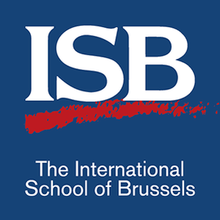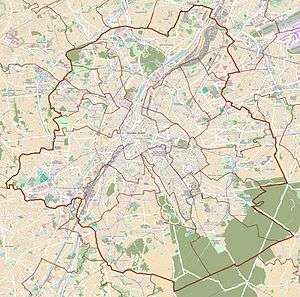International School of Brussels
| International School of Brussels | |
|---|---|
 | |
| Location | |
 International School of Brussels  International School of Brussels | |
|
Brussels Belgium | |
| Coordinates | Coordinates: 50°47′20″N 4°25′1″E / 50.78889°N 4.41694°E |
| Information | |
| Type | Private school |
| Motto | Everyone Included, Challenged, Successful |
| Established | 1951 |
| Head teacher | Lee Fertig |
| Faculty | 200 |
| Number of students | 1,500 |
| Campus | 162,134.62 m2 |
| Mascot |
 |
| Website | http://www.isb.be/ |
The International School of Brussels (ISB) is an English-language international school that provides an international education to over 1500 students aged 2½ to 19 from 62 countries. Its 40-acre (16 ha) campus lies in the Brussels commune of Watermael-Boitsfort, about 9 kilometres (5.6 mi) southeast of the city centre.[1]
History
The International School of Brussels opened in October 1951 with four teachers and twenty-seven students between the ages of 5 and 11. It was located in the Brussels commune of Woluwe-Saint-Pierre.[2]
By the end of the 1953 term the school was home to about one hundred students and had moved to its current location at the Château des Fougères, in the Brussels commune of Watermael-Boitsfort. It also changed its name from the American School of Brussels to the International School of Brussels.
In its early years, the entire school was housed in the old Château des Fougères. The classrooms had desks with inkwells and students were taught how to take a pen (which was basically a fountain pen nib on a stick), dip it in the inkwell (built into the desk) and write their assignments.
ISB became an International Baccalaureate school on 1 January 1977 making it the 50th IB school worldwide.[3]
In February 2006 the school board opted to begin fundraising because it determined that the tuition charged to its students was insufficient for its needs.[4]

Buildings and campus
ISB is located on a 162,134.6-square-metre (1,745,202 sq ft) wooded campus. Green is the predominant colour on campus. All of the buildings use new 'green' technologies, and trees planted by Middle School students dot the grounds. Surrounding the school is managed forest, with entries to the Brussels region's extensive forest trails across the campus.
The campus includes an outdoor track, a performing arts center, two gymnasiums, and 15 hectares (37 acres) of playing fields and woods are located on the campus.[4]
The 19th century building called the "Château" is the school's administration building. Decorated with pillars, the building houses a reception area that hosts parents of prospective students.[4] It is the first building that visitors see and houses the reception area and administrative offices. The remaining buildings, which include the four schools, the performing arts centre and the gymnasiums are scattered throughout the campus, which also has extensive sports fields, covered play areas and a running track.
Academic buildings
Most classes at ISB are housed in one of four main buildings.
- Early Childhood Centre (ECC): students aged 2½ to 8, Head Sasha Marshall
- Elementary School (ES): students aged 8 to 12, Head Anna Zeiders
- Middle School (MS): students aged 12 to 15, Head Mike Crowley
- High School (HS): students aged 15 to 19, Head Felim Bolster
Additional buildings
- The Student Activity Centre, or Annex, houses the two gymnasiums, a recently renovated theatre, and additional high school classrooms.
- The Metairie houses the extensive music program offered at ISB.
- The International Community Centre (ICC) houses the ISBPlus and Lifelong Learning programmes, as well as the International Protestant Church.
Academics
ISB offers the four core courses – Language Arts, Mathematics, Social Studies, and Science. In addition, ISB students take either French, English Language Development, or Study Skills. High School Students at ISB are offered either the International Baccalaureate or a combination of International Baccalaureate certificate courses and ISB courses both of which routes lead to a US High School Diploma accredited by the Middle States Association of Colleges and Schools. The most recent reaccreditation occurred in 2010. The school itself offers two tiers of diplomas. Unique among many international schools, ISB also offers a Special Education Diploma.
ISB also offers courses in many other languages. From beginner to mother tongue levels, Spanish, Dutch, German, Japanese, Hebrew, and other languages are available either in-school or through the ISBPlus programme.
A total of 45 IB courses are offered[3]
Demographics
As of 2017 it had 1,500 students ranging in age from 2 to 19. The students originate from 65 countries.[4]
As of 2012 most high school-aged Japanese residents of Brussels attend ISB.[5] The Japanese companies employing the parents of these children subsidize their tuition.[6]
Pang Ching-lin (彭靜蓮, Pinyin: Péng Jìnglián), author of Negotiating Identity In Contemporary Japan: The Case of Kikokushijo, wrote that due to a language barrier and different after-school social life many Japanese students felt isolated from Anglophone student groups such as the Americans and Swedes and often clustered together.[7] Japanese students are enrolled in an English as a second language programme which has a different curriculum than the regular programme. Students who succeed in English ability move on to the regular programme. The Japanese students made their friends within the ESL programme and continued to socialize with these friends even after they graduate to the English-medium courses.[6] Japanese students did participate in after-school activities depending on the gender.[7] Pang wrote that the ESL program for Japanese students "is often referred to both by school administrators, parents and youngsters as one of the major reasons for the rather insular character of the Japanese in the overall school environment."[6]
Pang wrote that many Japanese students had difficulties in writing and speaking English, and he added that because they translated their thoughts from Japanese to English, many "did not succeed in producing an essay in Standard English".[8] Pang added that there were some Japanese students who had previously lived in English-speaking countries and had gained proficiency or mastery in English.[8]
Tuition
The school charges different levels of tuition based on age. As of 2017 the price for a pre-kindergarten student is €18,500 per year, rising to €36,500 for a student in the High School.[9] As of 2006 its annual income from tuition was €27.9 million.[4]
Athletics
ISB’s athletic program offers more than 50 individual and team sports over a three-season year. These include baseball, basketball, cross country, golf, lacrosse, swimming and soccer. ISB is also the only international school in Europe to have American football and lacrosse teams as of 2011. These U12, junior varsity, and varsity sports compete in both the International School Sports Tournament (ISST) and Department of Defense Dependents Schools (DoDDs) leagues. Non-competitive and intramural programs are also offered for younger children.
ISB has a range of sports facilities. There is an outdoor grass field, and two full-size artificial ones as well as a track for running and field events. There are two indoor tennis courts, two large gymnasiums, and an Outdoor Education Centre.
ISBPlus
ISBPlus is an extra-curricular programme at ISB that offers students opportunities for extended learning in areas that interest them.
References
- Pang, Ching-Lin. Negotiating Identity In Contemporary Japan: The Case of Kikokushijo. Routledge, October 2, 2012. ISBN 1136178120, 9781136178122.
- Pang, Ching Lin (Catholic University of Leuven Department of Anthropology). "Controlled internationalization: The case of kikokushijo from Belgium." International Journal of Educational Research. Volume 23, Issue 1, 1995, Pages 45–56. Available online 20 January 2000. DOI 10.1016/0883-0355(95)93534-3. - Discusses Japanese students at ISB
Notes
- ↑ "Belgium, Brussels: International School of Brussels".
- ↑ https://internationalschoolcommunity.com/blog/tag/teaching-at-international-schools/page/3/
- 1 2 "International School of Brussels".
- 1 2 3 4 5 Conlin, Jennifer. "International schools get serious on funds." International Herald Tribune at The New York Times. Monday October 16, 2006. Retrieved on January 4, 2014.
- ↑ Pang, Negotiating Identity In Contemporary Japan, p. 249.
- 1 2 3 Pang, "Controlled internationalization: The case of kikokushijo from Belgium," p. 51.
- 1 2 Pang, Negotiating Identity In Contemporary Japan, p. 254.
- 1 2 Pang, Negotiating Identity In Contemporary Japan: The Case of Kikokushijo, p. 256.
- ↑ "Tuition Fees - International School of Brussels". www.isb.be.